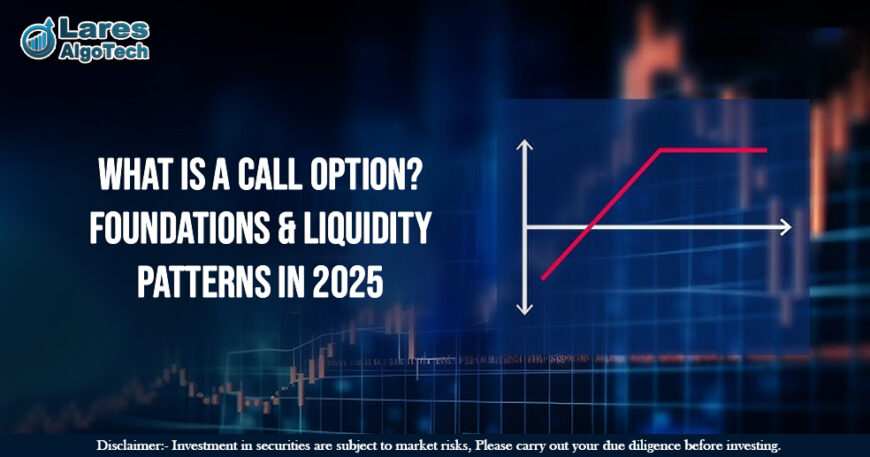📌 Introduction: Call Options in the Modern Market
The year 2025 marks a significant evolution in derivatives trading in India and globally. With increased retail participation, smarter AI-driven platforms like Lares Algotech, and enhanced regulatory clarity, options—especially call options—are taking center stage.
A call option gives the buyer the right, but not the obligation, to buy an asset (typically a stock or index) at a specified price (strike price) before a set expiration date.
This simple definition opens up a complex world of strategies, liquidity considerations, and risk-reward dynamics. In this blog, we’ll explore the foundation of call options and examine how liquidity patterns are reshaping in 2025.
What Is a Call Option?
Let’s begin with the basics.
🧠 Definition
A call option is a derivative contract that gives the buyer the right to buy the underlying asset at a pre-agreed strike price on or before the expiry date.
- Buyer: Pays a premium for the right.
- Seller (Writer): Receives the premium and assumes the obligation to sell if exercised.
⚙️ Example:
Suppose you buy a call option for Stock X with:
- Strike Price: ₹1,000
- Premium: ₹50
- Expiry: 1 month from now
If Stock X rises to ₹1,200, you can buy at ₹1,000 and profit. Your net gain = ₹1,200 – ₹1,000 – ₹50 = ₹150.
If the price stays below ₹1,000, the option expires worthless, and you lose only the premium.
Key Terminologies in Call Options
Understanding these terms is crucial to navigating the options market:
| Term | Meaning |
| Strike Price | The fixed price at which you can buy the underlying asset |
| Premium | The cost of buying the option |
| Expiry | The date when the option contract ceases to exist |
| In The Money (ITM) | When the market price is higher than the strike price |
| At The Money (ATM) | When the market price equals the strike price |
| Out Of The Money (OTM) | When the market price is below the strike price |
Call Option Payoff Structure
The payoff profile for call options is asymmetrical:
- Maximum Loss: Limited to the premium paid
- Maximum Profit: Unlimited (as underlying price can rise infinitely)
This asymmetric reward structure is what makes call options a popular choice for bullish traders.
Why Trade Call Options?
In 2025, the demand for call options is surging because of the following reasons:
Leverage
You control a large number of shares by paying a small premium.
Limited Risk
Unlike futures, your maximum loss is limited to the premium.
Directional Bets
Perfect for traders expecting upside movement in stocks, indices, or commodities.
Hedging
Used by portfolio managers to hedge short-term downside while retaining long positions.
Intrinsic Value vs Time Value
🔹 Intrinsic Value
= Spot Price – Strike Price
(Only applicable for ITM options)
🔹 Time Value
= Premium – Intrinsic Value
Time value erodes as expiry approaches—this is known as Theta decay.
In 2025, advanced option pricing models and AI tools help traders precisely calculate these values in real-time, enhancing accuracy.
How Are Call Options Priced?
The pricing of call options is driven by the Black-Scholes Model or similar quantitative models. Key factors include:
- Spot Price of the underlying
- Strike Price
- Time to Expiry
- Volatility (Implied and Historical)
- Risk-free interest rate
- Dividends (if any)
In 2025, algorithmic platforms like Lares Algotech use real-time volatility feeds and predictive analytics to fine-tune option pricing models for better execution.
Liquidity Patterns in Call Options – 2025 Trends
🔍 What Is Liquidity?
Liquidity in options refers to how easily you can buy/sell contracts without significantly affecting the price.
Indicators of Liquidity:
- Tight Bid-Ask Spreads
- High Open Interest
- High Volume
How Liquidity Patterns Have Evolved in 2025
🧠Retail Participation & Weekly Options
The popularity of weekly expiries has driven short-term liquidity spikes, particularly in index options like NIFTY and BANKNIFTY.
🤖Rise of Algorithmic Trading
Algo-based institutions and traders deploy scalping and hedging bots, improving market depth and lowering spreads.
📅Event-Driven Liquidity
Macro events (RBI announcements, earnings, Fed policy, Budget Day) create temporary surges in call option volume.
📈Preferred Strikes
Strikes near round numbers (e.g., 20,000 NIFTY) often show concentrated liquidity pools, making them ideal for intraday and swing traders.
🌐Cross-Asset Options
Options on ETFs, bonds, and international stocks (via IFSC exchanges like GIFT City) are becoming more accessible, adding diverse liquidity avenues.
How Lares Algotech Helps Navigate Liquidity
Lares Algotech provides traders with an advanced liquidity heatmap, powered by:
- Real-time OI and volume spikes
- Historical trade data modeling
- Volatility-adjusted liquidity indicators
This helps clients identify the best call options to trade based on depth, trend, and momentum.
Popular Call Option Strategies in 2025
| Strategy | Purpose | Market View |
| Long Call | Bullish directional play | Strongly Bullish |
| Bull Call Spread | Limited profit, lower cost | Moderately Bullish |
| Covered Call | Income generation | Neutral to mildly bullish |
| LEAPS (Long-term calls) | Long-term bets on uptrend | Bullish with time |
Pro Tip: Lares Algo trading bots can automate complex option spreads across expiries and strikes.
Call Options vs Futures
| Factor | Call Option | Futures |
| Risk | Limited to premium | Unlimited |
| Margin | Only premium required | High margin |
| Profitability | Unlimited upside | Linear payoff |
| Complexity | Slightly complex (Greeks) | Easier to understand |
| Flexibility | Ideal for retail & hedging | Preferred by institutions |
In 2025, options are increasingly preferred by new-age traders looking to limit risk while maximizing returns.
Risk Factors in Call Option Trading
Though call options offer leverage and low capital entry, risks include:
- Time Decay (Theta): Option value erodes with time
- Volatility Drop (Vega): A drop in implied volatility can reduce premiums
- Wrong Directional Bet: Asset may not move above strike price
Risk Management Tip: Always define a stop-loss or exit plan when buying calls. Lares Algotech’s strategy builder comes with built-in risk control modules.
Regulatory Framework for Options in 2025
- SEBI’s tightened margin norms and enhanced risk disclosure mechanisms have made retail option trading safer.
- Platforms must display “Riskometer” grades based on contract volatility.
- Algo trading in options is allowed only via SEBI-approved brokers like Lares Algotech, ensuring compliance and transparency.
What’s Next in Call Options?
As markets evolve, we expect to see:
- Tokenized Options: Tradable contracts backed by crypto and blockchain
- AI-Powered Signal Services: Predictive alerts based on option flow and dark pool data
- Mobile-First Option Trading: Simplified UX for retail traders via apps
Lares Algotech is already developing auto-adjusting option strategies tailored to volatility clusters and intraday liquidity cycles.
🧾 Conclusion: Call Options Are the Future of Smart Trading
Whether you’re a retail trader, hedge fund manager, or tech-savvy investor, understanding what a call option is and how liquidity behaves in 2025 is crucial to outperforming the market.
With platforms like Lares Algotech, traders get access to next-gen analytics, algo integration, and real-time data—all designed to make options trading smarter, safer, and more profitable.
📣 Ready to explore the power of call options?
Join Lares Algotech today and unlock a new dimension of intelligent options trading.






 .facebook.com/lares.algotech
.facebook.com/lares.algotech  instagram.com/laresalgotech/
instagram.com/laresalgotech/  x.com/AlgoLares
x.com/AlgoLares  whatsapp.com/channel/...
whatsapp.com/channel/...  .linkedin.com/company/lares-algotech/
.linkedin.com/company/lares-algotech/  youtube.com/@LaresAlgoTech
youtube.com/@LaresAlgoTech